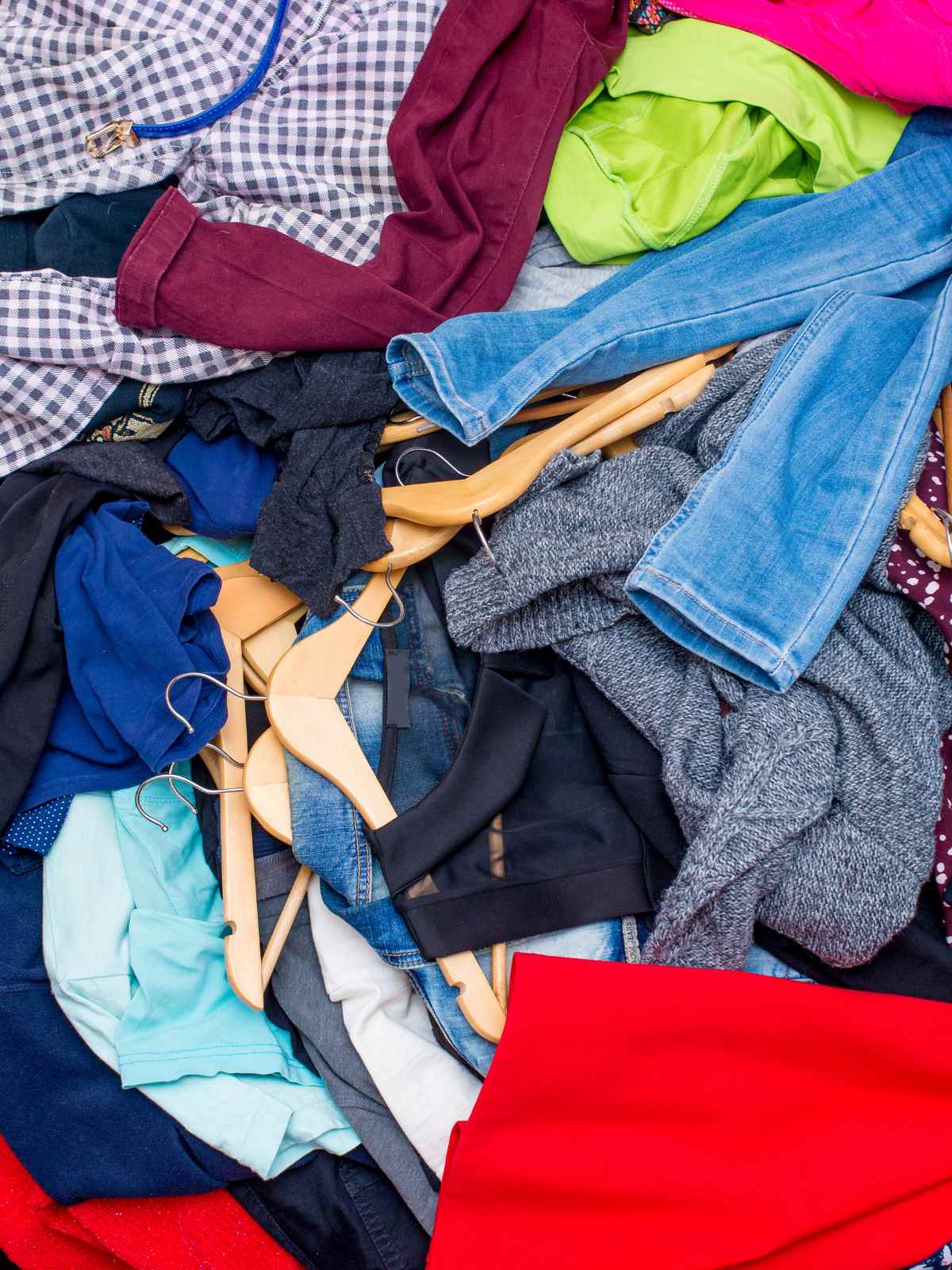Fast-growing brand SHEIN suing marketplace Temu for design theft epitomises the irony plaguing the industry. As more fast fashion giants battle each other in court, Maggie Zhou reports on how countless small brands, who’ve long alleged their designs were stolen, are left to watch from the sidelines. Meanwhile, the market continues to flood with cheap copycats.
Small brands keep falling victim to design theft
Australian designer Rachel Burke is known for her handmade, dopamine-fuelled wearable art pieces. These one-off creations are a labour of love, often made from deadstock fabrics and upcycled finds. How is it, then, that photos of said designs—and Burke wearing them—ended up on dropshipping site, AliExpress? “Now it’s just been flattened, it’s completely devoid of meaning,” she said on TikTok in early September.
This is another all-too-common example of an independent designer accusing a fast fashion giant of ripping off her designs. There are now reams of widely reported cases of small labels having their designs blatantly copied by bigger brands to then be sold at demoralisingly low prices.
H&M sues SHEIN. Temu sues SHEIN. SHEIN sues Temu. This is the vicious, unending cycle of design theft metastasising the fashion industry. It’s like a dog chasing its own tail; it’s akin to the Spiderman pointing at Spiderman meme. And who’s left on the sidelines? Small brands that have long alleged the giants have profited off of their intellectual property while harming their businesses’ growth in the process—as if small sustainable brands didn’t already have enough to deal with.
Yes, for small brands, it’s not easy to challenge alleged theft, no matter how obvious it may seem to their audiences on social media. Jenny Wyndham-Wheeler, principal and patent attorney at Griffith Hack, explains to me that “to prove design infringement, the registered design owner needs to show that the design and the alleged infringing work are ‘substantially similar in overall impression’. There is no ‘intent’ in this infringement test.”
At this point, design theft has become an expected part of fashion, and as lawsuits continue to proliferate, where does the industry—and importantly, the small brands that tend to rate much better on their sustainability policies compared with the ultrafast fashion competitors—go from here? I spent the past month investigating this question, and never expected to hear from SHEIN or Temu directly. Here, I break down the growing design theft crisis, the responses from the giants, and hear from small designers on how they move forward when all SHEIN offers you is $500.
Fast fashion’s never-ending race to the bottom
One brand, in particular, is frequently accused on social media of design theft. That’s SHEIN, which Good On You’s rating team assessed as “We Avoid” due to its ultra fast fashion business model and lack of transparency.
The pattern that emerges across the allegations looks troubling. California-based knitwear maker Bailey Prado alleged that SHEIN stole over 45 designs. Nigerian label Elexiary claimed SHEIN stole its sweater design—one that would take one of its artisans four to five days to crochet. French mother-and-daughter label MaisonCléo had its designs copied by SHEIN, which eventually removed the pieces from its site after significant public scrutiny, only to circle back a few months later daring to ask the small label for a collaboration.
Established brands don’t appear to be immune, either. Global retailers such as Ralph Lauren, Levi Strauss & Co., Puma, Adidas, and Dr. Martens have sued SHEIN. LA-based luxury label Chrome Hearts has filed over 100 lawsuits in the last five years for copyright infringement against retailers including Fashion Nova, Guess, JCPenney, Target, Walmart, and, yes, also SHEIN.
We’ve even reached a point where the fast fashion giants accuse each other of rip-offs, as well. Last year, Swedish fast fashion conglomerate H&M sued SHEIN for alleged copyright infringement. From swimwear to sweaters, dozens of items have been put under the microscope. But many observers were quick to point out the hypocrisy: H&M, one of the most well-known faces of fast fashion, is no stranger to using art without permission.
It’s a matryoshka doll set of irony. “They’re suing other brands for the shady practices they’ve used for years to amass billion-dollar profits, only to turn around and claim to be the victim of the same crime they’ve been perpetrating. It’s comical,” sustainable fashion educator and researcher Nina Gbor tells me.
But the most farcical battle of the moment is between ultra fast fashion competitors SHEIN and Temu. The e-commerce giants are stuck in a race to the bottom. Most recently in August 2024, SHEIN filed a lawsuit against Temu, stating the platform was “built on counterfeiting, theft of trade secrets, infringement of intellectual property rights and fraud.”
In the 80-page complaint, SHEIN not only lays out its copyright infringement claims (the documents declare many violations of this) but outlines other insidious and unsavoury tactics Temu allegedly uses. SHEIN argues that Temu has misled consumers by aligning itself with SHEIN in its advertisements, creating fake social media accounts pretending to be SHEIN, and instructing social media influencers to discredit its competitor.
The most farcical battle of all is the one between ultra fast fashion competitors, SHEIN and Temu.
On the flip side, Temu previously sued SHEIN for its “mafia-style intimidation and detention scare tactics” which saw the defendant allegedly employing aggressive techniques to enforce anticompetitive exclusive-dealing agreements so its suppliers wouldn’t work with Temu.
Responding to SHEIN’s latest lawsuit, a Temu spokesperson told TIME: “The audacity is unbelievable […] SHEIN, buried under its own mountain of IP lawsuits, has the nerve to fabricate accusations against others for the very misconduct they’re repeatedly sued for.”
So why are we seeing more and more fashion businesses becoming tied up in lawsuits? “The companies that are involved in the many fashion law court battles taking place worldwide have decided to prioritise the enforcement of their intellectual property (IP) rights,” Juliet Evans, associate and lawyer at Griffith Hack, explains. “This strategy can have a preventative effect. It puts competitors on notice that certain brands will not tolerate IP infringement.”
At a time when “dupes” (duplicate products that are similar yet more affordable than their original counterparts) are at an all-time high, it makes sense that more brands are investing in protecting their IP.
Evans points to Scandinavian brand Ganni’s viral Buckle Ballerina shoes as an example. “A Danish court recently granted an interim injunction in favour of Ganni, preventing Steve Madden from selling its Grand Ave shoe in Denmark on the basis that Ganni’s shoe is an original work of applied art and eligible for copyright protection,” Evans tells me. “Although the legal matter is ongoing and the ultimate result is unknown, Ganni has sent a message to the market that it is willing to protect its valuable IP.”

SHEIN and Temu respond to small designers’ allegations
SHEIN and Temu have been consistently named in allegations of design theft in recent years. I reached out to both brands to give them an opportunity to respond to what many small designers have been saying across social media. I didn’t expect them to reply. But both brands provided PR responses saying they take this all very “seriously,” the statements read.
A representative for SHEIN—which is currently planning an IPO on the London Stock Exchange—wrote to me: “SHEIN respects designers and artists, and the intellectual property rights of others. We take all claims of infringement seriously. When legitimate complaints are raised by valid IP rights holders, SHEIN promptly addresses the situation, and removes the product(s) from our site as a matter of caution while we investigate.”
SHEIN also defended itself by suggesting it was, in fact, a massive supporter of small designers. The brand’s representative shared details of “SHEIN X—the programme under SHEIN—[which] collaborates with independent brands, artists and designers to launch exclusive collections.”
SHEIN told me it’s launched an astonishing 46,000 styles through SHEIN X. This is not surprising, as SHEIN is notorious for promoting overconsumption of cheap products—independent research shows that the brand can have as many as 600,000 distinct items listed on its platform at once. This excessive amount demonstrates the sheer power that it can wield over global supply chains and anyone who tries to challenge it.
Temu “significantly expands” its IP team to process claims
Temu, on the other hand, told me that its marketplace model means the responsibility for design theft is with its third-party sellers. “Each product listing on our platform is created and managed by these independent sellers. Before they can set up their stores and list products, every seller must sign an agreement to operate lawfully, protect consumers’ rights and intellectual property, and comply with the legal standards and regulations of their markets.”
If all this sounds familiar, it might be because Temu has previously used its marketplace business model to similarly shift responsibility onto its sellers for the high risk of products sold on its site being manufactured using forced Uyghur labour.
In its statement to me, the brand detailed the actions it takes when it receives an intellectual property violation complaint, which includes removing the listings, suspending listing privileges, or terminating sellers’ accounts. “In September last year, we upgraded from processing complaints via email to launching a dedicated IP protection portal for rights holders […] to make it easier for them to submit and track their cases,” the spokesperson wrote.
“As our business has grown, we have significantly expanded our IP protection team, leading to quicker and more efficient processing of complaints.”
But if the brand is receiving so many intellectual property complaints that it had to set up a portal and significantly expand its team, we have to question: just how frequently is this happening? And is it really feasible for small brands to go up against such behemoth brands in cases of design infringement?
Why it’s so hard for small brands to challenge the giants
When small, independent labels have designs copied by larger manufacturers, seeking legal protection is often too costly to justify. “Sometimes it actually makes me not want to share my work,” designer Burke shared on TikTok.
“It makes me feel that I’m creating prototypes … for a business like AliExpress … It is always a David and Goliath situation. You’re always going up against a massive company, and more often than not, you end up just dropping out of the race or settling for a small amount,” she said in the video.
And small amounts they are. When ‘Davids’ step up to ‘Goliaths,’ the results are often lacklustre. Krista Perry, a Massachusetts-based designer, was offered $500 from SHEIN after confronting the retailer about allegedly stolen designs, which she rejected.
Gbor explains that: “An artist’s work is sometimes born out of the soul—personal life experiences which are a cocktail of joy, pain, trauma, dreams [and] culture… To have that stolen via design theft is a real violation.”
Emily Watson is an emerging Australian designer whose avant-garde, demi-couture designs have caught the attention of a few fast fashion companies, allegedly including Temu. Watson tells me “it is frustrating and disheartening to see a big company presumably turn a profit on designs which utilised months of my labour to develop.” I put Watson’s allegations to Temu as an example of what other designers have claimed, and a PR spokesperson said the company would investigate.
Design theft is delaying the sustainable fashion industry from growing
Nina Gbor
In the post-pandemic economy, independent labels are already struggling. Overheads, labour, marketing, and material are already so pricey for smaller businesses. Adding to that list of costs is design theft, which can almost seem like an inevitability, rather than something that’s immoral (or rather, illegal).
“It bolsters the idea that plagiarism is justifiable because it’s become so common,” sustainable fashion educator Gbor adds. “Design theft is delaying the sustainable fashion industry from growing, blossoming and thriving. Taking legal action can be expensive, time-consuming and effort[ful].”
While the likes of SHEIN, Temu, and H&M can afford to go head-to-head in court while still operating business as usual, the same isn’t true for small brands. Most can’t afford the costs of lawyering up. And the proliferation of cheaper lookalikes could severely impact the demand for original designs—potentially eroding the market share and profitability of independent designers who can’t compete on price or marketing reach. Just when a brand achieves that rare feat of a popular style or aesthetic, design theft can put that success into question.
Designer Watson isn’t too worried, though. “I don’t feel it affects my creative process. The key defining characteristics of my designs, I imagine, would be impossible for a fast fashion company to do a good job at copying,” she says, referring to her intricate detailing and unique pattern-cutting methods.
Quality and craftsmanship cannot be duplicated by ultra fast fashion giants. Time and care cannot be faked. True ethical fashion cannot be duped. So while designers like Watson and Burke pore over their art, and small brands vocalise their rage and frustrations on social media, SHEIN and Temu will be in court, fighting for scraps.




















